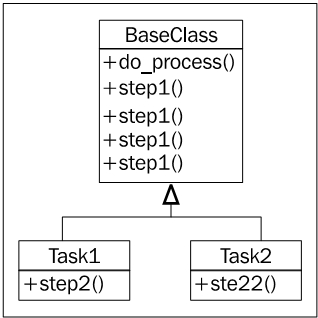The template pattern is useful for removing duplicate code; it's an implementation to support the "Don't Repeat Yourself" principle we discussed in Chapter 5. It is designed for situations where we have several different tasks to accomplish that have some, but not all, steps in common. The common steps are implemented in a base class, and the different steps are overridden in subclasses to provide custom behavior. In some ways, it's like a generalized strategy pattern, except similar sections of the algorithms are shared using a base class. Here it is in UML format:

Let's create a car sales reporter as an example. We can store records of sales in an SQLite database table. SQLite is a simple file-based database engine that allows us to store records using SQL syntax. Python 3 includes SQLite in its standard library, so there is no setup involved.
We have two common tasks we need to perform:
- Select all sales of new vehicles and output them to the screen in a comma-delimited format
- Output a comma-delimited list of all salespeople with their gross sales and save it to a file that can be imported to a spreadsheet
These seem like quite different tasks, but they have some common features. In both cases, we need to perform the following steps:
- Connect to the database.
- Construct a query for new vehicles or gross sales.
- Issue the query.
- Format the results into a comma-delimited string.
- Output the data to a file or e-mail.
The query construction and output steps are different for the two tasks, but the other steps are identical for both. We can use the template pattern to put the common steps in a base class, and the varying steps in two subclasses.
Before we start, let's create a database and put some sample data in it, using a few lines of SQL:
import sqlite3
conn = sqlite3.connect("sales.db")
conn.execute("CREATE TABLE Sales (salesperson text, "
"amt currency, year integer, model text, new boolean)")
conn.execute("INSERT INTO Sales values"
" ('Tim', 16000, 2010, 'Honda Fit', 'true')")
conn.execute("INSERT INTO Sales values"
" ('Tim', 9000, 2006, 'Ford Focus', 'false')")
conn.execute("INSERT INTO Sales values"
" ('Gayle', 8000, 2004, 'Dodge Neon', 'false')")
conn.execute("INSERT INTO Sales values"
" ('Gayle', 28000, 2009, 'Ford Mustang', 'true')")
conn.execute("INSERT INTO Sales values"
" ('Gayle', 50000, 2010, 'Lincoln Navigator', 'true')")
conn.execute("INSERT INTO Sales values"
" ('Don', 20000, 2008, 'Toyota Prius', 'false')")
conn.commit()
conn.close()
Hopefully you can see what's going on here even if you don't know SQL; we've created a table to hold the data, and used six insert statements to add sales records. The data is stored in a file named sales.db. Now we have a sample we can work with in developing our template pattern.
Since we've already outlined the steps that the template has to perform, we can start by defining the base class that contains the steps. Each step gets its own method (to make it easy to selectively override any one step), and we have one more all-encompassing method that calls the steps in turn. Without any method contents, here's how it might look:
class QueryTemplate:
def connect(self):
pass
def construct_query(self):
pass
def do_query(self):
pass
def format_results(self):
pass
def output_results(self):
pass
def process_format(self):
self.connect()
self.construct_query()
self.do_query()
self.format_results()
self.output_results()
The process_format method is the primary method to be called by an outside client. It ensures each step is executed in order, but it does not care if that step is implemented in this class or in a subclass. For our examples, we know that three methods are going to be identical between our two classes:
import sqlite3 class QueryTemplate: def connect(self): self.conn = sqlite3.connect("sales.db") def construct_query(self): raise NotImplementedError() def do_query(self): results = self.conn.execute(self.query) self.results = results.fetchall() def format_results(self): output = [] for row in self.results: row =[str(i) for i in row] output.append(", ".join(row)) self.formatted_results = " ".join(output) def output_results(self): raise NotImplementedError()
To help with implementing subclasses, the two methods that are not specified raise NotImplementedError. This is a common way to specify abstract interfaces in Python. The methods could have empty implementations (with pass), or could even be fully unspecified. Raising NotImplementedError, however, helps the programmer understand that the class is meant to be subclassed and these methods overridden; empty methods or methods that simply do not exist are harder to identify as needing to be implemented and to debug if we forget to implement them.
Now we have a template class that takes care of the boring details, but is flexible enough to allow the execution and formatting of a wide variety of queries. The best part is, if we ever want to change our database engine from SQLite to another database engine (such as py-postgresql), we only have to do it here, in this template class, and don't have to touch the two (or two hundred) subclasses we've written.
Let's have a look at the concrete classes now:
import datetime class NewVehiclesQuery(QueryTemplate): def construct_query(self): self.query = "select * from Sales where new='true'" def output_results(self): print(self.formatted_results) class UserGrossQuery(QueryTemplate): def construct_query(self): self.query = ("select salesperson, sum(amt) " + " from Sales group by salesperson") def output_results(self): filename = "gross_sales_{0}".format( datetime.date.today().strftime("%Y%m%d") ) with open(filename, 'w') as outfile: outfile.write(self.formatted_results)
These two classes are actually pretty short, considering what they're doing: connecting to a database, executing a query, formatting the results, and outputting them. The superclass takes care of the repetitive work, but lets us easily specify those steps that vary between tasks. Further, we can also easily change steps that are provided in the base class. For example, if we wanted to output something other than a comma-delimited string (for example: an HTML report to be uploaded to a website), we can still override format_results.
